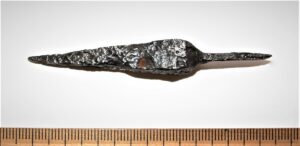Database
Our database is free to use for all history and archaeology enthusiasts. If you use our database, please do not forget to cite correctly:
Mägi, Marika; Palm, Piia Sandra. Archaeological Artefacts of Saaremaa. Foundation Osiliana / Tallinn University. Accessed: date.
The Osiliana Archaeological Database presents artefacts from Saaremaa and the surrounding small islands.
The database contains mainly Iron Age and Medieval finds that can be classified.
Undated metal or other pieces were generally excluded from the database.
Ceramics are represented by isolated examples.
The database is a work in progress and is constantly being updated.

Valjala hillfort
Spiral.

Valjala hillfort
Spiral.

Valjala hillfort
Fragment of a bronze spiral bracelet, re-used as hook or tweezers.

Valjala hillfort
Fragment of a bronze spiral bracelet, decorated with triangles.

Valjala hillfort
Iron artefact, awl or arrow head. Dated according to the find context.
Valjala hillfort
Iron crossbow head. Such heads have been found in several medieval castles and in 2012 also from Haapsalu.

Iron crossbow head. Such heads have been found in several medieval castles and in 2012 also from Haapsalu (Russow & Allmäe 2013). Mäesalu has dated such crossbow-heads in Estonia to the first half of the 13th century due to some finds in hill-forts, what he associates with sieges known from written sources (Mäesalu 1991, 174-175). Such crossbow-heads in Latvia have been dated to the second half of the 13th century and the first half of the 14th century (Mugurēvičs 2008, 192, 202, Griciuvienė 2005, 202), in Russia to the 13th-15th century (Medvedev 1966, 116, Pl 31: 28).
Literature:
Медведев А.Ф. 1966. Ручное метательное оружие (Лук и стрелы, самострел). VIII–XIV вв. М.: Наука6.
Mäesalu, A. 1991. Otepää linnuse ammunooleotsad. Eds. L. Jaanits & V. Lang. (Muinasaja teadus, 1). Agu, Tallinn.
Griciuvienė, E. (prepared by) 2005. Žiemgaliai. Baltų archeologijos paroda. Katalogas. The Semigallians. Baltic Archaeological Exhibition. Catalogue. Vilnius – Riga, Lietuvos nacionalis muziejus; Latvijas Vēstures muzejs.
Mugurēvičs, Ē. 2008. Viduslaiku ciems un pils Salaspils novadā. Rīga, 112, 202.
Russow, E. & Allmäe, R. 2013. From a suburban pasture to the urban cemetery – recent fieldwork in north-western corner of medieval Haapsalu. – Archaeological Fieldwork in Estonia 2012, 217-232.
Valjala maalinn
Semi-manufactored row, iron. Such finds in Sigtuna have been associated with ship-building.

Semi-manufactored row, iron. Such finds in Sigtuna have been associated with ship-building (Edberg 2013).
Literature:
Edberg, R. 2013. Subterranean Maritime Archaeology in Sigtuna, Sweden: Excavated evidence of Viking Age boat building and repair. – International Journal of Nautical Archaeology 42(1), 196-204.

Mullutu
Tip of an iron knife.

Valjala hillfort
Whetstone.
The negative value refers to time Before Christ.




